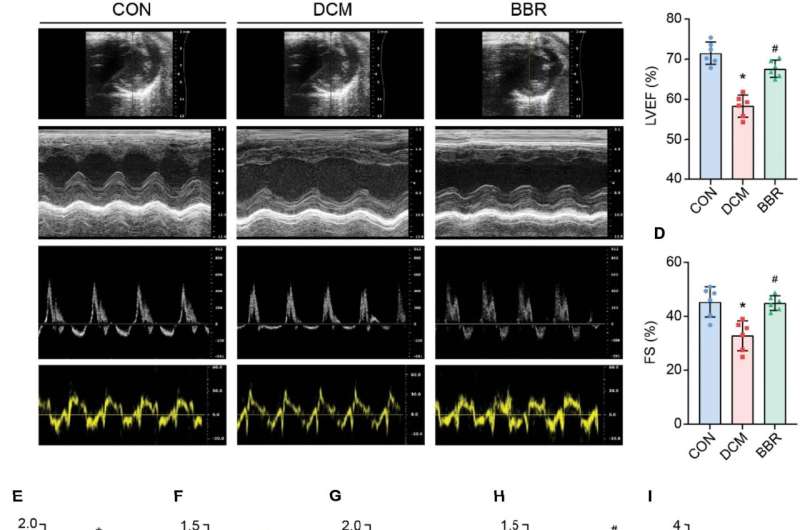Experiment timeline and echocardiographic measurements in three groups of mice. (A) Experiment timeline in three groups of mice. (B) Representative echocardiographic images in mice: (1) Two-dimensional echocardiogram showing left ventricular short-axis view; (2) M-mode echocardiogram showing left ventricular dimensions; (3) Pulse-wave Doppler echocardiogram depicting diastolic mitral flow; (4) Tissue Doppler echocardiogram displaying mitral annular velocities. (C) Measurements of left ventricular ejection fraction (LVEF) in mice. (D) Measurements of left ventricular fractional shortening (FS) in mice. (E) Measurements of left ventricular posterior wall (LVPW) thickness in mice. (F) Measurements of interventricular septum (IVS) thickness in mice. (G) Measurements of the ratio of early to late diastolic mitral flow velocities (E/A) in mice. (H) Measurements of the ratio of early to late diastolic mitral annular velocities (E´/A´) in mice. (I) Measurements of left ventricular end-diastolic diameter (LVEDD) in mice. *P < 0.05 vs. the control group; #P < 0.05 vs. the DCM group; n = 6. Credit: Cardiovascular Innovations and Applications (2023). DOI: 10.15212/CVIA.2023.0064
Diabetic cardiomyopathy is a multifaceted complication of diabetes that lacks effective treatments. Berberine (BBR), a bioactive compound from Rhizoma coptidis, has potential therapeutic implications, but its precise role in diabetic cardiomyopathy has yet to be defined.
In a new study published in Cardiovascular Innovations and Applications, a diabetic cardiomyopathy model was established by administration of a high-fat diet and streptozotocin injection to C57BL/6J mice. Concurrently, the mice received BBR treatment daily for a duration of eight weeks. After the treatment period, myocardial injury, cardiac function, and the levels of oxidative stress and apoptosis were assessed.
BBR significantly ameliorated cardiac dysfunction and histopathological damage caused by diabetic cardiomyopathy. This treatment also elevated serum superoxide dismutase levels while decreasing malondialdehyde levels. The anti-apoptotic activity of BBR was evidenced by a decrease in TUNEL-positive cells and the percentage of apoptotic cells, as determined by flow cytometry, in conjunction with diminished levels of BCL2-associated X protein/B cell lymphoma 2 (BAX/BCL2) in heart tissues.
Mechanistically, BBR was found to ameliorate diabetic cardiomyopathy by upregulating the expression of myocardial methionine sulfoxide reductase A (MsrA) and concurrently suppressing cardiac CaMKII oxidation.
BBR alleviates diabetic cardiomyopathy by inhibiting myocardial apoptosis and oxidative stress through the MsrA and CaMKII signaling pathways.
More information: Xiaoqiang Sun et al, Berberine Ameliorates Diabetic Cardiomyopathy in Mice by Decreasing Cardiomyocyte Apoptosis and Oxidative Stress, Cardiovascular Innovations and Applications (2023). DOI: 10.15212/CVIA.2023.0064
Provided by Compuscript Ltd
























